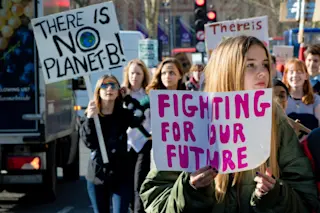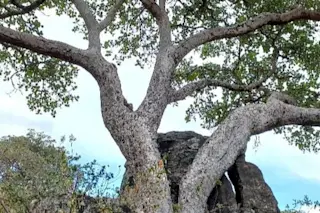Each year on April 22, communities around the world celebrate Earth Day and focus on how we can all nurture the environment. But how did this global observance begin?
Earth Day, first held in 1970, has grown from a series of campus teach-ins to a worldwide event celebrated by millions. This annual day of action serves as a reminder of our ongoing struggle to protect our planet.
When Was the First Earth Day?
Organizers of the first Earth Day reportedly scheduled the event on a Wednesday to avoid conflicting with the “weekend activities” that college students enjoyed.
That must have been the right call. That April 22, 1970, hundreds of campuses across the country hosted lectures, protests, and clean-ups, alongside citywide events in Washington, D.C. and New York City.
Why is Earth Day Important?
The environmental movement has changed since the first Earth Day. In the last half century, climate change entered the radar of organizers and the public. More people have learned about environmental justice, or the idea that everyone deserves the benefits of environmental improvements. Even with these revelations, there’s more that residents and governments must confront to achieve widespread environmental change, says Mark Roseland, a sustainability researcher at Arizona State University.
“The biggest challenge for the environmental movement 50 years on is to be able to connect to other movements,” he says. Without those partnerships, environmental progress might always be seen as a burden.
Read More: We’ve Lost 35 Percent of Forests in the Past 300 Years
Attitudes Before the First Earth Day
Before the first Earth Day in 1970, the default Western attitude viewed the environment as something we could, and should, control. As David Brower, a prominent environmentalist, once explained, “the implicit assumption is that Man is the Master of Nature, and that losing a wild place or species or plant is of no great importance to us, and never mind the esthetics.” Even when Earth Day first kicked off, most people’s concept of the environment was as a separate, cordoned-off part of the world distinct from where they lived. “Those things that aren’t in that ‘environmental’ box,” Roseland says, “we didn’t have to pay attention to.”
By the late 1980s, more of the public learned that disentangling ourselves from the environment was going to be more difficult than it sounded. Denis Hayes, one of the founding leaders of Earth Day, warned attendees of a scientific meeting about the ecological consequences of fossil fuel burning in 1980.
In 1987, countries around the world agreed to scale back production of chemicals that were eroding the Earth’s ozone layer. The choices we were making in cities, the way we grew food, moved around and powered our lives — things that didn’t fit the classic definition of “nature” — had a bigger impact on the environment than many had realized, Roseland says.
Read More: Chronic Fear of Environmental Doom? You're Not Alone
How an Environmental Movement Changed Legislation
Accepting that many aspects of our lives impact the environment puts a new, challenging twist on passing effective legislation. “It’s easier to regulate the environment if you don’t think you’re part of it,” Roseland says. Research indicates that Americans tend to think these collective actions are hard to pull off, too.
A study in the journal Risk Analysis found that people believe government action on climate issues is more effective — but harder to accomplish — than individual choices. “Our respondents seem alive to the collective action problem at the heart of climate change mitigation,” the study authors write.
Roseland says that some of the daunting challenge of environmental progress lies in how relatively isolated the movement has been from other social causes. For starters, “the environmental movement was perceived for so long as being white and middle class and male,” he says.
But people of color had been fighting for protections against environmental hazards in their workplaces and neighborhoods since at least the 1960s. Some of the largest environmental nonprofits acknowledge they still have a lot of work to do to diversify who they represent and fight for.
Read More: How to Save Planet Earth
Earth Day Can Help Fight for Social Reform
Fighting for socioeconomic and environmental reform simultaneously leads to solutions for both causes. Community-owned solar panels can provide a sustainable and more affordable energy source for low-income residents, for example. The economic benefits of an environmental initiative must stand out too, Roseland says. For too long, environmental change was pitted against financial benefits. “If it comes down to the environment versus the economy, the environment is always going to lose,” he says.
Finding solutions that ease social, financial and environmental challenges requires a lot of collaboration across disciplines. That can be difficult for large, bureaucratic systems to navigate, and is part of why Roseland — who focuses on sustainable urban development — hopes that individual cities will have an easier time managing this kind of reform.
So far, environmental and climate movements have a lot left to accomplish. Countries are struggling to meet emissions reduction pledges in the Paris Agreement, and individual U.S. cities and states are falling short of recycling goals. Reform will take a lot more work, with a lot more people, Roseland says. “The only way to get innovation on that scale is to get extremely participatory.” If the goal is widespread, multidisciplinary yet hyperlocal movements, then maybe there are still lessons future environmental action has yet to learn from the very first Earth Day.
Read More: How to Build Your Own Rain Garden and Why You Should
Article Sources:
Our writers at Discovermagazine.com use peer-reviewed studies and high-quality sources for our articles, and our editors review for scientific accuracy and editorial standards. Review the sources used below for this article:
The Journal of Environment & Development. Environment: Evolution of a Concept
Mark Roseland. Sustainability researcher at Arizona State University
Committee on Interior and Insular Affairs. Hearings, reports and prints of the Senate Committee on Interior and Insular Affairs 93rd
Cross Currents. Man Against Nature: Hidden Assumptions in the Argument over Environmental Control
Harvard Gazette. How Earth Day gave birth to environmental movement
U. S. Department of State. The Montreal Protocol on Substances That Deplete the Ozone Layer
Risk Analysis. Efficacy Foundations for Risk Communication: How People Think About Reducing the Risks of Climate Change
The Sierra Club. Glass Houses: Exclusion in the Environmental Movement
Yale School of Environment. Energy Equity: Bringing Solar Power to Low-Income Communities
This article was originally published on April 22, 2020.














